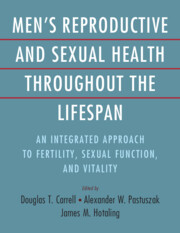 Men's Reproductive and Sexual Health Throughout the Lifespan
Men's Reproductive and Sexual Health Throughout the Lifespan from Section 5 - Medical and Surgical Management of Issues of Male Health
Published online by Cambridge University Press: 06 December 2023
Exogenous testosterone functions as a male contraceptive. As a result, men treated with testosterone who desire fertility will need help when trying to restore or preserve fertility. In this chapter, we provide a framework for counseling and managing hypogonadal men who desire fertility. We explore strategies ranging from cessation of exogenous testosterone to using human chorionic gonadotropin, selective estrogen receptor modulators, aromatase inhibitors, or recombinant follicle-stimulating hormone with or without testosterone to preserve Sertoli and Leydig cell function. Furthermore, we provide strategies to maintain fertility while starting testosterone and clinical pathways for a hypogonadal man to recover fertility based on his desired timeline for a pregnancy.
To save this book to your Kindle, first ensure no-reply@cambridge.org is added to your Approved Personal Document E-mail List under your Personal Document Settings on the Manage Your Content and Devices page of your Amazon account. Then enter the ‘name’ part of your Kindle email address below. Find out more about saving to your Kindle.
Note you can select to save to either the @free.kindle.com or @kindle.com variations. ‘@free.kindle.com’ emails are free but can only be saved to your device when it is connected to wi-fi. ‘@kindle.com’ emails can be delivered even when you are not connected to wi-fi, but note that service fees apply.
Find out more about the Kindle Personal Document Service.
To save content items to your account, please confirm that you agree to abide by our usage policies. If this is the first time you use this feature, you will be asked to authorise Cambridge Core to connect with your account. Find out more about saving content to Dropbox.
To save content items to your account, please confirm that you agree to abide by our usage policies. If this is the first time you use this feature, you will be asked to authorise Cambridge Core to connect with your account. Find out more about saving content to Google Drive.